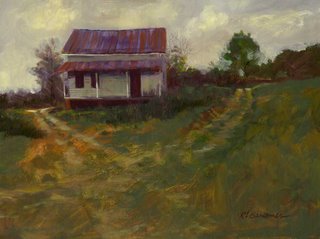Here is a
question emailed to me and I thought I'd answer it here.
It's from Lynn in Sikeston, MO.
Lynn says, "I have a question on sunset paintings. Each
evening on my way home from work, I watch these beautiful sunsets with
vivid colors. Silhouetted against the sky, the trees and buildings
seem very dark, but I cannot find the color answer to paint them.
While they appear very dark, painted dark looks very harsh and
unbelievable. Any advice?"
The subject of sunsets is often selected by students when I do
workshops. Generally, I'd say stay away from doing them but if tackling
the subject I try and remember a few things.
1. Try and make notes
of color either mental or better yet with a very quick thumbnail sketch on
location to record the colors in the sky and use those color notes when
doing the painting.
2. Remember that when using a photograph of a
sunset, the camera will not see even a small portion of the colors that
the eye can see in real life especially when looking at a high contrast
subject such as a sunset. The photo will either wash out the sky colors
and leave you with the land portion exposed correctly OR if the camera is
exposed for the sky, the photo will leave you with a black landscape.
Chances are you aren't going to get a good exposure on the sky and the
land in one shot. This puts any artist at a disadvantage when painting
from a photo.
3. I never use black on a sunset painting. A sunset
painting is all about color and black will kill it. I use a mix of
transparent colors such as alizarin crimson and thalo blue or ultramarine
blue to give a very dark color. I stay away from using any opaque colors
when trying to make these darks or at least I might use them very
sparingly. For instance maybe a small touch of burnt sienna in the dark
areas as in the painting below. When I use black it is always to make a
color greyer and not necessarily darker.
4. Remember the landscape
becomes very secondary in most sunset paintings and usually ends up as silhouette. Detail usually becomes soft.

TO SEE MORE OF THESE "FLORIDA WILDERNESS" PAINTINGS
CLICK
HERE. |
5. Consider doing a sunset painting before the last minute
of sunset when the landscape still has more light on it. Here's an example
of that.
6. I try and stay away from bright colors when painting a landscape.
Maybe a touch or two of a pure color is fine but using too many pure
colors will give the painting a false and harsh look like the one
below.
7. Remember that a sunset painting needs more to it than a horizontal
line across the center and some clouds and sun at the top half. It needs
to have a subject and just dividing the picture up into those two areas
like the photo above leaves the viewer with little or no real interest or
subject matter to enjoy. There are always lots of people at the beach at
sunset taking such photos but a good photo or painting needs more than a
split screen of sky and water. It's also not a good idea to divide the
canvas right in the middle.

























